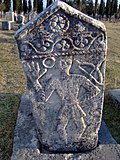Fustanella
traditional pleated skirt-like garment worn by men of the Balkans From Wikipedia, the free encyclopedia
Remove ads
Fustanella (Greek: φουστανέλλα; Albanian: fustanellë/fustanella; Aromanian: fustanelã; Bulgarian: фустанела, romanized: fustanela; Macedonian: фустан, romanized: fustan) is a pleated, or folded, skirt like a Scottish kilt. It is worn by men from different countries in Southeast Europe.

History


The fustanella originates from ancient Greek clothing like the chiton (or tunic) and the chitonium (or short military tunic).[2] An ancient Greek statue in Attica shows a stonecutter named Archedemus wearing a folded skirt like the fustanella.[3] The ancient Roman toga may have also impacted the development of the fustanella.[4]
In the Byzantine Empire, the fustanella was worn and called the podea (Greek: ποδέα).[5][6] It was commonly used in Greek lands as early as the 12th century AD.[1] In Byzantine art and music, the wearer of the podea was either a hero or a Greek warrior defending the empire's borders.[6][7] The fustanella was part of a military outfit consisting of bows, swords, battle-axes and armor (corselet or chain mail).[1][4] In the Ottoman Empire, the fustanella was worn by Greek guerillas like the klephts and the armatoloi.[8] In Albania, the fustanella is first mentioned in 1335 in a list of items taken from a sailor at the port of the Drin River.[9]
The Albanian fustanella is based on the Greek fustanella.[10] But the difference is in the number of pleats. The "Bridegroom's coat" is a Greek fustanella with two-hundred pleats that a bride would buy as a wedding gift for her groom.[11] The Albanian fustanella has around sixty pleats or usually a moderate amount of folds.[12]
Remove ads
Gallery
- Statue of a young man wearing a chiton; Roman copy of a Greek original (4th century BC).
- Gravestone depiction of an Aromanian wearing a fustanella (15th century AD).
- Lord Byron in Albanian Dress painted by Thomas Phillips (1813).
- Souliote Warrior painted by Louis Dupré (1820).
- A Souliot in Corfu Nikolos Pervolis painted by Louis Dupré (1827).
- Greek general of the Royal Phalanx in full dress uniform (1835).
- At the Carnival in Venice painted by Mikhail Scotti (1839).
- A group of upper-class Albanians in typical dress (circa 1850–1900).
- Albanian leader Hamza Kazazi (circa 1858).
- Greek Warrior painted by Carl Haag (1861).
- Russian picture of a Greek and an Albanian (1862).
- Arnaut Smoking in Cairo, Egypt painted by Jean-Léon Gérôme (1865).
- Ilyo Voyvoda, a Bulgarian Macedonian revolutionary (1867).
- Albanian in Cairo by Jean-Léon Gérôme (circa 1880).
- Albanian Officer painted by Jean-Léon Gérôme (1894).
- Spiridon Louis, Olympic marathon champion (1896).
- Vlach shepherd in traditional attire (early 1900s).
- Aromanian leader Ioryi Mucitano (early 1900s).
- Ioannis Ramnalis, a Greek Macedonian revolutionary (after 1908).
- Old man wearing the fustanella in Arcadia, Greece (circa 1920s).
- Royal Guard of Albania (1921).
- Sarakatsani, or Greek nomads, in Western Macedonia, Greece (1935).
- Sarakatsani, or Greek nomads, in Thrace (1938).
- Changing of the guards at the Tomb of the Unknown Soldier (2005).
- Greek Presidential Guard officer, Athens (2007).
Remove ads
Related pages
References
Further reading
Other websites
Wikiwand - on
Seamless Wikipedia browsing. On steroids.
Remove ads

























